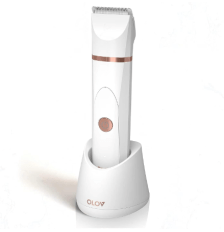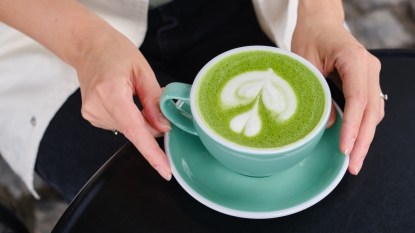Can You Have BV and Yeast Infection At The Same Time? Yes! Ob/Gyns Share the Best At-Home Remedies for Both
You'll be amazed at how much better *everything* down there feels with these pH-enhancing tips

If you’ve ever had a yeast infection (and research shows that 75% of us have), you’re all too familiar with the telltale symptoms like itching, burning and discharge. And many women get the pesky infections again and again. But sometimes, those symptoms aren’t a sign of a yeast infection at all! Gynecologists are reporting that many women who think they have a yeast infection are self-misdiagnosing a totally different vaginal condition called bacterial vaginosis (BV). Both conditions come with similar uncomfortable symptoms and it can be hard to tell them apart. For that reason, many women are asking, “Can you have BV and a yeast infection at the same time?” The answer is yes. The good news is that it’s possible to cure both infections. Read on for the must-know info.
“One of the big misconceptions is every time someone thinks they have vaginal irritation or odor or an abnormal discharge, they think it’s yeast, and in fact, most times, it’s not,” says Lauren Streicher, MD, an associate clinical professor of obstetrics and gynecology at Northwestern University. “Most times, it’s bacterial vaginosis, which is an imbalance in the bacteria in the vagina.” It’s surprisingly common, with research showing that up to 30% of the time women with BV also have yeast overgrowth.
If you’re not sure whether you have a yeast infection or bacterial vaginosis (or both, ugh!), doctors agree that it’s crucial that you visit the gynecologist to see what’s going on. Here, what you need to know about these conditions and how you can get relief.
Yeast infection basics
It’s normal for a yeast called Candida albicans to live in the vagina. But everything from birth control pills and hormone therapy to antibiotics and uncontrolled diabetes can cause the vaginal tract to become more hospitable to the yeast, which then overgrows, leading to symptoms like vaginal discharge, itching and burning during sex or while urinating, says Barbara DePree, MD, a certified menopause practitioner and founder of MiddlesexMD.com.
Bacterial vaginosis basics
Age-related hormone fluxes, menstruation and even sex can bring a rise in vaginal pH that allows harmful bacteria to flourish, leading to bacterial vaginosis, a condition that causes odor and an itchy, irritating discharge, explains Laura Corio, MD, author of The Change Before The Change. Normally, the vaginal pH is pretty low, between 3.5 to 4.5, which allows the healthy bacteria in your body to thrive. But if something elevates the pH — such as sexual intercourse or the use of lubricants and douches — the “good bacteria” have trouble thriving and the “bad” bacteria start to take over.
Related: Bacterial Vaginosis Home Remedies: Docs Reveal What to Try + What You Absolutely Should Skip
How to tell if it’s a yeast infection or bacterial vaginosis
If you have a yeast infection, you can expect to see a white, thick vaginal discharge that resembles cottage cheese. You’ll probably feel very itchy down there, and you may spot some redness on the vulva and around the opening of the vagina. You may also notice a mild yeasty odor, but it probably won’t be too strong of a smell.
Both BV and yeast infections cause burning and itching, but fishy odor and a thin grayish discharge are hallmark signs of BV, says Dr. Corio. And unlike a yeast infection, there does tend to be a strong fish-like odor with bacterial vaginosis. This odor can get even worse after you have intercourse.
To determine which one you have, see your doctor for a vaginal swab. If the test confirms BV, your doctor can prescribe antibiotics to kill the infection.
If you’re prone to repeat yeast infections, you likely keep over-the-counter treatments on hand. But before you use them, Dr. Corio says you might find it helpful to test your vaginal pH using an at-home kit (like AZO Vaginal pH Test Kit, Buy on Amazon, $14.01 for 2 tests). Simply insert the cotton swab in your vagina, then apply to the included pH test pad. A normal pH is 3.5 to 4.5; a pH of 5 or higher is abnormal. “If your vaginal pH is abnormal, you should see a doctor, who can determine the cause and prescribe targeted treatment,” advises Dr. Corio. (Click through to learn what to do about a yeast infection that won’t go away.)
How to treat BV
If you discover that you do have bacterial vaginosis, your doctor will prescribe antibiotics to treat it. And while antibiotics will kill the bacteria that cause BV, they can also knock out the vagina’s healthy flora, leaving you vulnerable to recurrence. Thankfully, these natural options are proven to treat BV and keep future infections at bay:
Spoon up yogurt

“Since the depletion of good vaginal bacteria (lactobacillus) is the root cause of BV, it makes sense to replenish them,” says Dr. DePree. “Studies have shown a 60% reduction in infections in women who eat probiotic-enhanced yogurt daily for 30 days.” (Click through for a simple recipe to make your own probiotic yogurt). Don’t like yogurt? Dr. DePree advises taking a probiotic with lactobacillus once daily (like Nature’s Way Probiotic Pearls for Women, Buy on Amazon, $10.75 for 30).
Try vitamin C this way
Inserting a 250-mg. vitamin C tablet into the vagina for six days in a row cured BV for 86% of women in a study published in the Journal of Clinical Medicine Research. How it works: Vitamin C restores a healthy pH level in the vagina to enhance the body’s ability to fight off infectious bacteria. Dr. Corio recommends using an enteric-coated pill to avoid irritation to sensitive vaginal tissue and inserting a tablet twice weekly to prevent future infections.
How to keep BV from returning
“There is some scientific evidence that using over-the-counter vaginal probiotic capsules that contain lactobacilli (like VagiBiom, Buy on Amazon, $34.95 for 15 suppositories) can help protect against BV in women with a history of repeat infections — and you don’t have to use them every single day,” says Dr. DePree. One study found that a pattern of seven days on and seven days off reduced recurrence rates by 65%.
Finally, Dr. DePree notes, consider using hypoallergenic, fragrance-free soap, wearing breathable cotton underwear. You should also avoid douching since it disrupts the vagina’s balance of good to bad bacteria, which can trigger an infection.
How to treat a yeast infection
Antifungal medications
Antifungal medications like over-the-counter Monistat (Buy on Amazon, $12.97) and prescription Diflucan can treat yeast infections, but Dr. DePree notes that “certain strains of fungi, such as Candida albicans, the one responsible for most yeast infections, can become resistant to over-the-counter antifungal creams or suppositories.
There’s also Vivjoa, a newer prescription oral medication — the first treatment designed to treat repeat yeast infections, or recurrent vulvovaginal candidiasis (RVVC). “This antifungal drug is more effective than current antifungal treatment options because it’s less likely to cause antifungal resistance while still killing fungal growth,” says Dr. DePree. Although it’s not a quick fix (the medication must be taken for three months), 96% of women with RVVC using Vivjoa were free from recurrent infections for nearly a year. (Note: The medication isn’t recommended for women who are pregnant or breastfeeding.)
If you prefer natural strategies, consider these:
Vitamin B
A form of vitamin B-3 called nicotinamide reduces the number of candida cells by 67% and enhances the power of prescription antifungal drugs, say Chinese researchers. You can get B-3 from foods like eggs, dairy, poultry, fish and enriched grains or by taking a supplement, like Life Extension NAD+ Cell Regenerator (Buy on Amazon, $45 for 30 capsules).
This purple remedy
Gentian violet (GV) is an antiseptic that prevents candida spores from producing infection-causing proteins, and a 2022 study in the Journal of Obstetrics and Gynaecology found that women who used GV in addition to a prescription antifungal were more likely to cure the infection and did so one day sooner. What’s more, their infections were 55% less likely to return. To get the benefits, pour 2 tsp. of a diluted, 1% solution of GV (like De La Cruz Gentian Violet, buy on Amazon, $9.18 for a 1-oz. bottle) into a glass, soak a tampon in the solution and wear the tampon for up to 3 hours twice a day for three days. Note: GV stains skin and clothing, so consider using a pad or panty liner to protect your clothes.
Other smart strategies Dr. DePree recommends to help restore healthy vaginal pH levels and protect against future yeast overgrowth: reducing your intake of sugar and refined carbohydrates (yeast’s favorite food), avoiding douching and scented vaginal products that can disrupt the microbial balance and supplementing with a daily probiotic. (Click through to learn about the natural yeast infection cure that helped one woman heal and about kombucha for yeast infections)
This content is not a substitute for professional medical advice or diagnosis. Always consult your physician before pursuing any treatment plan.
Interested in more advice from ob/gyns? Keep reading!
Gynecologists Break the Silence On ‘Hair Down There’ Over 50 — All Your Questions Answered
Are Your Menopausal Nipple Changes Normal? Here’s What an Ob/Gyn Wants You To Know













